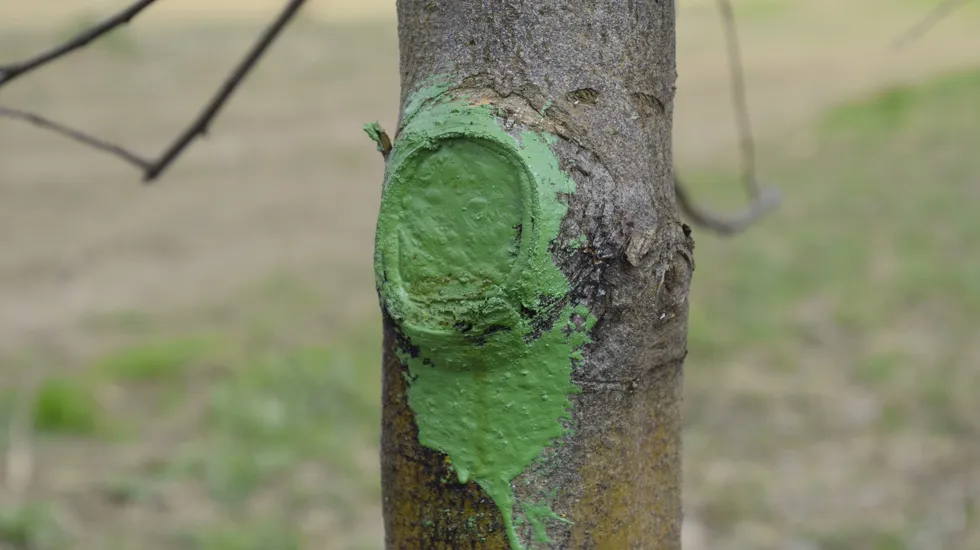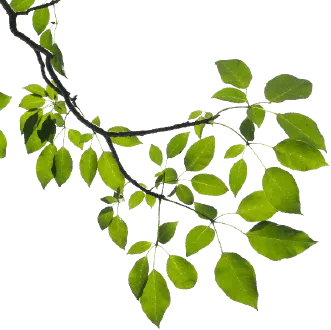If you’ve ever watched an arborist work or driven down a street full of recently pruned trees, you may have noticed that arborists sometimes paint the stubs left behind when branches are pruned. This leads many homeowners, property managers and landscaping professionals to wonder if they should do the same.
We’ll explore this issue below, explain why some arborists embrace the practice and explain why you probably shouldn’t paint the ends of cut tree branches.
Trees Don’t Heal; They Compartmentalize
Even though trees are living organisms, who aren’t so fundamentally different from other lifeforms on the planet, they have several features that distinguish them from other living entities. One of the most notable such features is the fact that they do not heal.
Any time you prune a tree, you are creating a wound – branches are meant to remain intact until they die and are shed. By cutting into the xylem (wood) of a branch, the tree becomes exposed to pathogens and pests. These can sicken the tree, lead to decay and ultimately cause the tree’s death. Accordingly, they’ve evolved adaptations to protect wounds from these types of threats.
However, as explained before, trees do not heal; instead, they’ve evolved a completely different way to handle wounds. Humans, goannas, emus and other animals who suffer wounds create new skin and tissue to seal up the wound. In most cases, all signs of the wound disappear in a short time.
But trees handle wounds differently. Instead of healing the actual wound, they simply produce new wood that grows around the wound and seals it off from the world. Once sealed off by new wood, the tree is no longer at high risk of decay or disease. But this means that the wound will never disappear – it only becomes compartmentalized.
Paint Can Make Things Worse
One of the problems with compartmentalization is that it is a slow process. It may take a tree months or years to completely seal off the wound left behind when a major branch is pruned. During this time, the tree remains partially exposed to pests and pathogens.
In light of this, arborists of decades past began painting these wounds with a little bit of non-toxic paint. This, it was thought, would help protect the tree from fungi, bugs and bacteria, while it produced wound wood to seal up the damaged limb.
However, research has shown that painting tree wounds is often counterproductive. It can retard the rate at which compartmentalization occurs, which is obviously detrimental to the tree’s well-being. Additionally, the paint can actually trap moisture in the wound, as well as bacterial and fungal spores. This creates a perfect environment for decay, and it can lead to further problems for the tree.
Given this new data, most arborists have stopped painting cut branches and other pruning-caused wounds. This has generally helped improve the odds that pruned trees will recover quickly and completely and helped avoid causing additional problems. Occasionally, unique circumstances will cause arborists to paint tree stubs, but the practice is not nearly as common as it once was.
So, if you find it necessary to prune the trees on your property, you’ll want to concentrate on placing the cuts in the proper location and using the proper tools to make the cuts, rather than painting the resulting stubs. This will give your trees the best chance to compartmentalize their wounds and maintain their vigor.
It is also worth pointing out that trees look much better when left in a natural state (even if they’ve been pruned), and painted stubs are often quite an eyesore. And thanks to the lessons arborists have learned over time, it no longer appears necessary – or even helpful – to engage in the stub-painting practice.
***
If your trees are in need of pruning, give your friends at Trav’s Tree Service a call. One of our experienced arborists will visit your property, examine the trees in question and recommend the best strategy to keep them healthy and safe. That way, you don’t even need to worry about painting the ends of stubs, the process of compartmentalization or the dangers involved in tree care – you can just sit back and relax, confident in the knowledge that your trees are in good hands.

%402x.svg)







